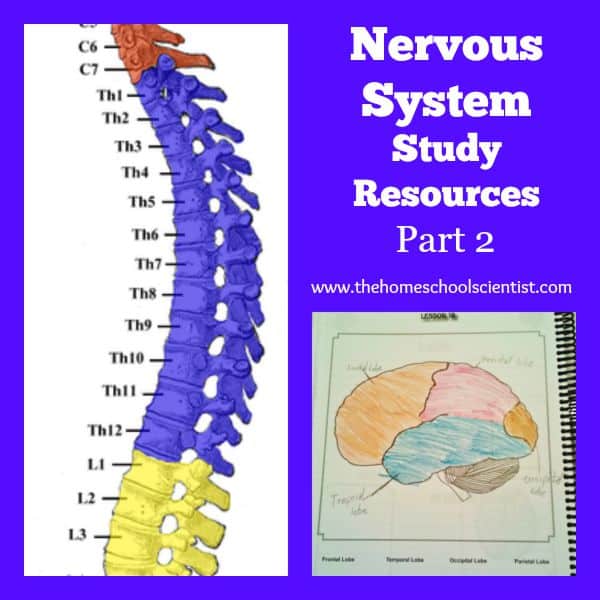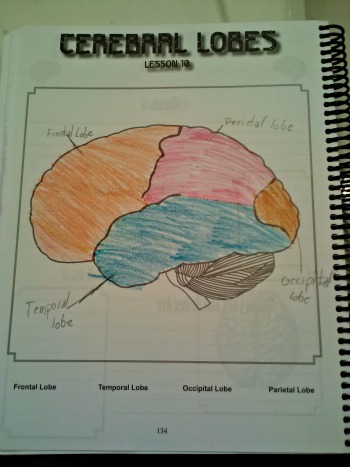Science Saturday – Nervous System Part 2

Last week here at Science Saturday, we started our study of the nervous system using Apologia’s Human Anatomy and Physiology. We looked at what makes up the the central and peripheral nervous systems. Plus, we looked closer at individual nerve cells. This week, we look at parts of the brain and the spinal cord in more detail and give you some ideas so you can do your own nervous system research at home.
Parts Of The Cerebrum

We learned previously that the cerebrum is where thoughts and decisions happen in the brain. The cerebrum is divided into four different areas, or lobes, each controlling a different thought process. The Apologia Human Anatomy and Physiology Notebooking Journal has great images and worksheets like the one above to visualize and remember all these new nervous system terms.
The frontal lobe controls reasoning, emotions, thoughts, ideas and parts of speech. This is the part of the brain that determines a person’s personality.
The parietal lobe integrates sensory information from various parts of the body. The parietal lobe,also, controls spatial orientation, speech, visual perception, recognition, perception of stimuli, pain and touch sensation.
The temporal lobe controls auditory processing. (hearing) It. also, controls the sense of smell and memory. Ever wonder why a smell can trigger a memory?
The occipital lobe processes visual information.

The Spinal Cord
The spinal cord is a bundle of nerves that is protected by 24 vertebrae, which make up the spinal column. Nerves exit the spinal cord through spaces in the spinal column. Each nerve controls a particular part of the body.
The spine itself is divided into 4 parts. The cervical vertebrae are located in the neck. Below the cervical vertebrae are the thoracic vertebrae. The lumbar vertebrae are located in the lower back and the sacral vertebrae are at the bottom of the spinal column.
Nervous System Experiments
Try these projects to test the ability and function of your nervous system.
Sequence – One person tells another a sequence of 4 numbers. The other person should recite them back in order. Keep doing this adding another number to the end. How high can you go?
Memory Game – Place 15 or 20 small household items on a cookie sheet. Allow your kids to observe them for 30 seconds, then take the cookie sheet away. Have them list as many items on the cookie sheet as they can recall.
Drop The Ruler– This is a fun experiment to test the time that it takes information to get from your eyes to your occipital lobe to your frontal lobe to your spinal cord and down to your hand. Hold a ruler with your thumb and index finger at the end with the highest measurement. Have your test subject put their thumb and index finger at the bottom of the ruler, slightly open. Without warning, drop the ruler. Write down the measurement on the ruler where your subject caught it. Repeat the experiment 3 or 4 times. Test your entire family. Who has the fastest reaction times?
Nervous System Links
- Nervous System Study Resources Part 1
- Lots of nervous system videos, quizzes, and games
- Amazing 3D tour of the brain from PBS.org
- MeetPenny.com – The other half of Science Saturday!
- Nervous System for Kids
- Neuroscience for Kids
- Brain and the Nervous System Crafts
- Nervous System Games
- The Meaning of Beep: Nervous System Game
- Neuroscience Experiments
- Nerve Experiment
- Paper Clip Experiment
- Virtual Lab
- Virtual Neurons
- Virtual Clinical Trials: WebAdventures Game Advances in Neuroscience
Check out the entire Science Saturday Human Anatomy and Physiology series!
Follow The Homeschool Scientist’s board Homeschool Anatomy on Pinterest.


